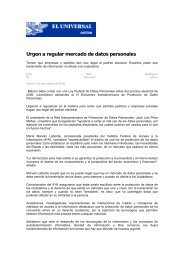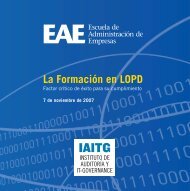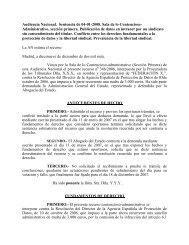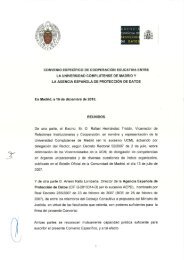access to public information and personal data protection 1 table of ...
access to public information and personal data protection 1 table of ...
access to public information and personal data protection 1 table of ...
You also want an ePaper? Increase the reach of your titles
YUMPU automatically turns print PDFs into web optimized ePapers that Google loves.
ACCESS TO PUBLIC INFORMATIONAND PERSONAL DATA PROTECTIONHuixquilucan (Mexico State), 4 th November 2005same time the <strong>personal</strong> <strong>data</strong> held by such government may not be disclosed <strong>to</strong>third parties without the consent <strong>of</strong> the <strong>data</strong> subject.1. THE BALANCE OF RIGHTSA discussion <strong>of</strong> the right <strong>to</strong> <strong>access</strong> <strong>to</strong> <strong>information</strong> <strong>and</strong> the right <strong>to</strong> <strong>personal</strong> <strong>data</strong><strong>protection</strong> obviously leads <strong>to</strong> a consideration <strong>of</strong> the limits on the exercise <strong>of</strong> theserights.One <strong>of</strong> the most complex aspects in the philosophy behind fundamental rights ishow <strong>to</strong> come <strong>to</strong> a reasonably fair solution in those cases where such rightsappear <strong>to</strong> conflict or collide. Perhaps the best way <strong>to</strong> find a solution in cases <strong>of</strong>conflict is <strong>to</strong> seek a different viewpoint, which first entails acceptance that thefundamental rights – <strong>and</strong> the obligations <strong>to</strong> which they give rise – are amicablyinterrelated or correlated.We might say that the fundamental rights have points <strong>of</strong> contact between them,rather than conflicts per se. The key is <strong>to</strong> seek out interpretational approaches <strong>to</strong>bring them <strong>to</strong>gether, so that conflicts are not insurmoun<strong>table</strong> <strong>and</strong> controversy,therefore, inevi<strong>table</strong>. Oppositional positions can lead inexorably <strong>to</strong> confrontationsthat can only be overcome by choosing one <strong>of</strong> the rights <strong>and</strong> ignoring the other.However, the principle <strong>of</strong> equality establishes that no rights shall be sacrificed forothers.Specifically within the scope <strong>of</strong> <strong>access</strong> <strong>to</strong> <strong>information</strong> <strong>and</strong> <strong>personal</strong> <strong>data</strong><strong>protection</strong>, there are points <strong>of</strong> conflict that merit exhaustive study <strong>and</strong> anindividualised interpretation in each specific case.2. PROOF OF BALANCE OR PUBLIC INTERESTBoth the right <strong>to</strong> <strong>access</strong> <strong>public</strong> <strong>information</strong> <strong>and</strong> the right <strong>to</strong> <strong>personal</strong> <strong>data</strong><strong>protection</strong> allow the establishment <strong>of</strong> certain limits, expressed in legal provisions10
















